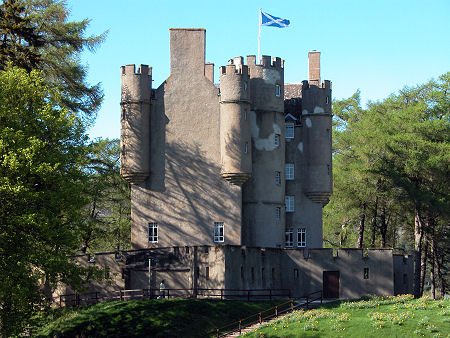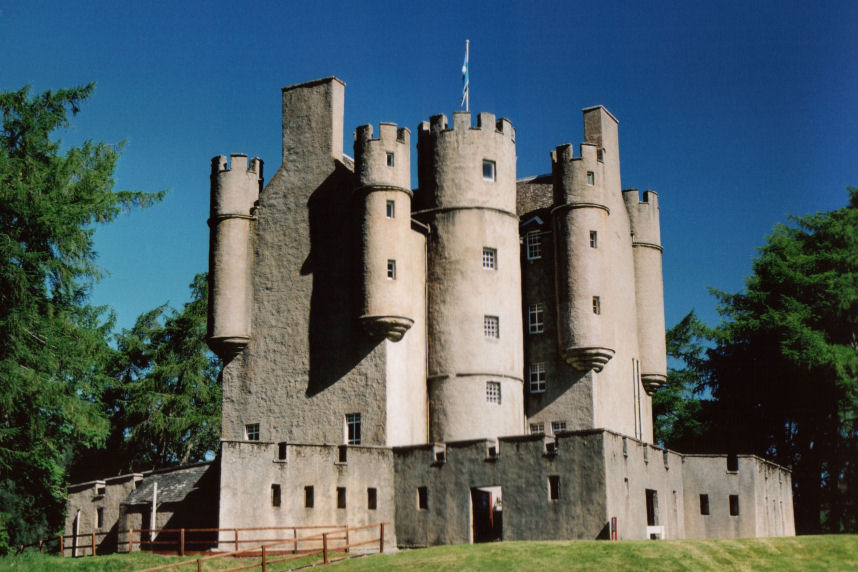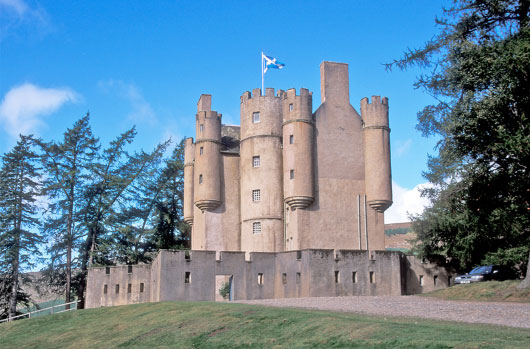Braemar Castle
Braemar Castle is a castle in the Valley of the Scottish River Dee in the field Braemars.
History
Braemar Castle was built from 1628 by John Erskine, 18th Earl of Mar, treasurer of James VI. Built. The castle served as a hunting lodge for extended hunting trips of the Scottish king, but also as a bulwark against the increasing power of the oriented to England clan Farquharson.
1689 succeeded the Farquharsons under the leadership of John Farquharson, the Black Colonel of Inverey to conquer the castle and burn down.
John Erskine, 23rd Earl of Mar, led to the Jacobite Rising of 1715. After the suppression of this revolt Braemar Castle was confiscated by the crown and given as a reward to the Clan Farquharson. However, the castle castle remained a ruin until 1748; after which it was leased on the condition that they re-establish, for an annual rent of £ 14 to the Crown, which used it as a garrison for Hanoverian troops.
A report from 1800 describes Braemar Castle as a castle with moat intact. 1831 stationed garrison was disbanded and the castle returned to the Clan Farquharson. Under the guidance of the 12th Laird of Invercauld the reconstruction began to a house, in which Queen Victoria resided before moving to Balmoral Castle, where she attended the Highland Games in Braemar.
2006 Braemar Castle was built, which still is in the possession of the Clan Farquharson, to the public. The castle is released to the public since 2008 and is now maintained by volunteers; that the revenues were a local charity.
Construction
Braemar Castle is a typical example of the "L Plan" - castle building the mid-18th century. Star-shaped pulls a curtain wall as a bastion around the castle; this requirement corresponded to the nature of his time and to the specifications of the architect as a defense against artillery fire (see also Vauban ).
The main tower of the castle is five stories high, built of granite and encloses a partially visible, circular stair tower. The entrance portal and many of the bars on the windows are original.
The ground floor with stone vaulted ceiling contains a barred access to the cellar dungeon, the room of the guards, the ammunition chamber and the original plates, which are incorporated into niches in the exterior walls. A second kitchen was installed in Victorian times.
The three floors above consist of a large room on the main and a small room in the adjoining tower, respectively. These are on the first floor of the Dining Room and the Morning Room; on the second floor you will find The Laird 's Day Room and the Rose Room. Between these lies a small, built in 1901 Bath. On the third floor are the Drawing Room, can be found in the early forms of graffiti, the Hanoverian troops to the shutters; and the Four Poster Bedroom. On the fourth floor you will find, unlike the scheme, three rooms: the Ladies Guest Bedroom, Guest Bedroom and the gentleman of the Principal Bedroom. The two upper floors were used until recently by members of the Farquharson family during their visits.
The interiors are richly decorated with stucco ceilings and wood paneling in Victorian style; the austere exterior of the castle is broken up by small oriel towers.









